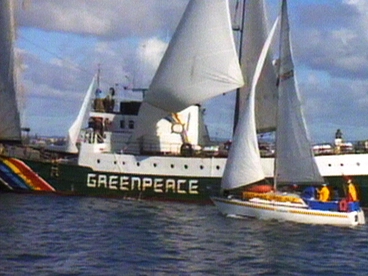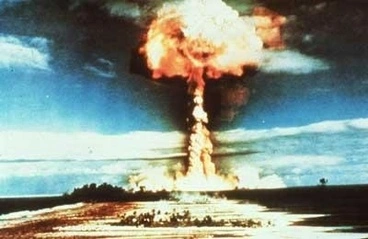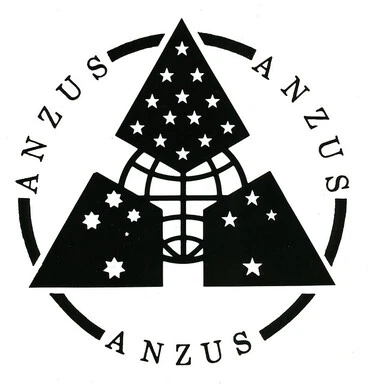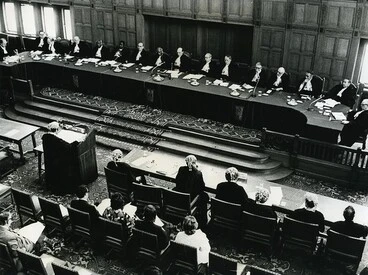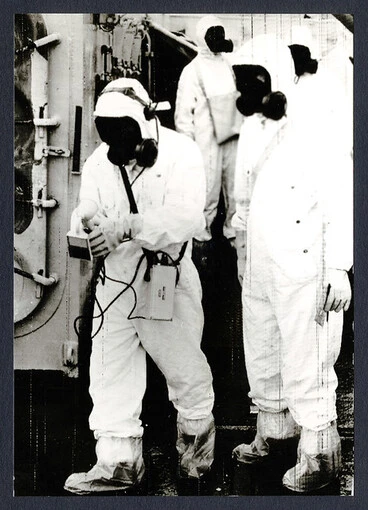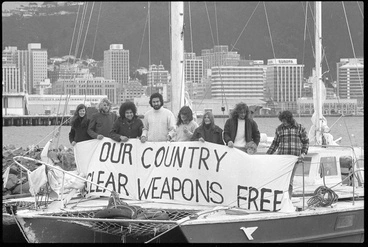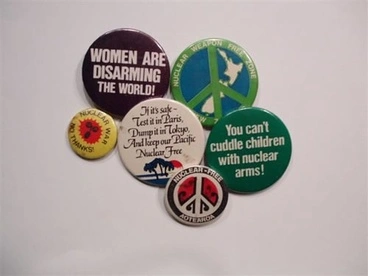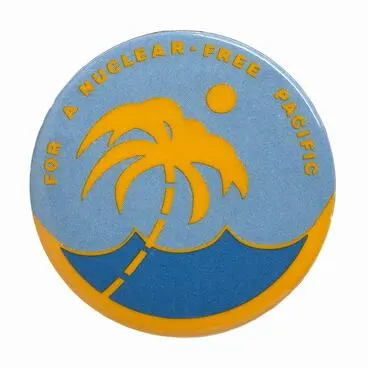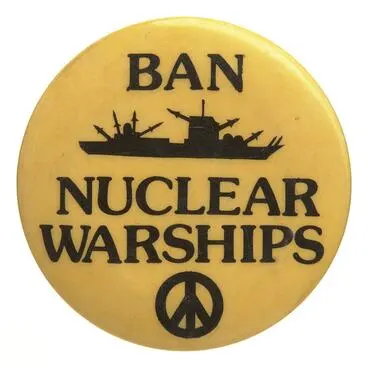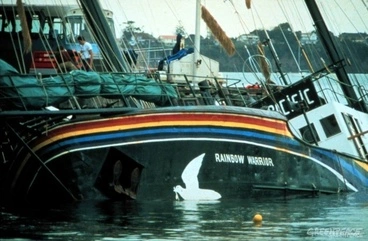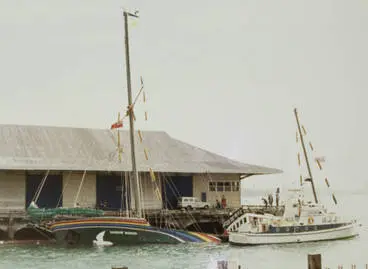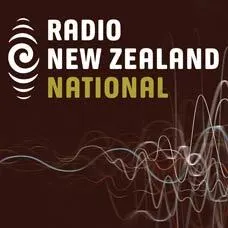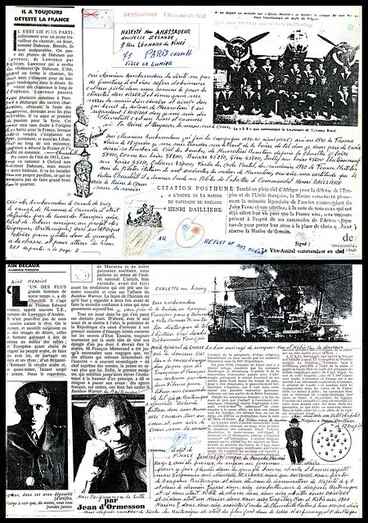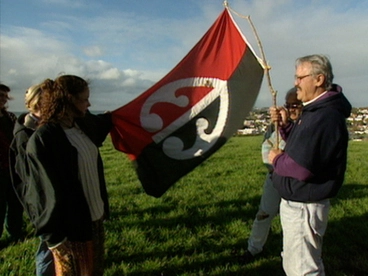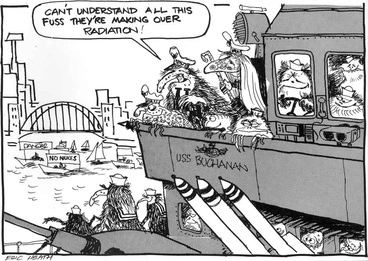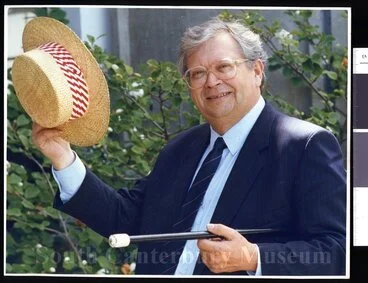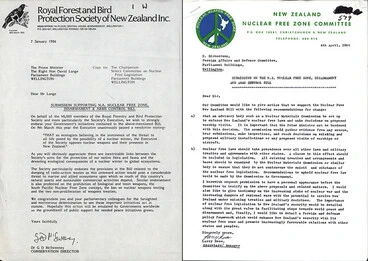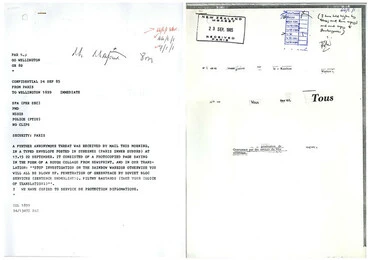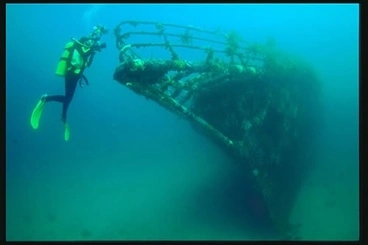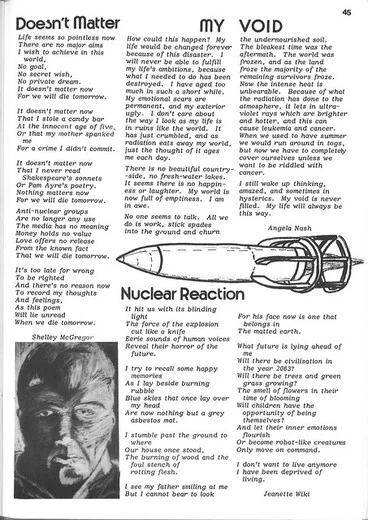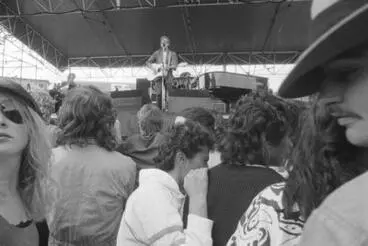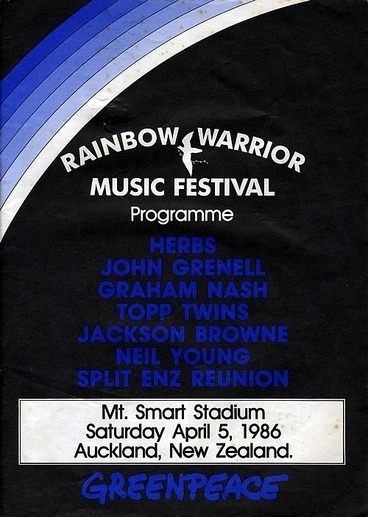The bombing of the Rainbow Warrior
A DigitalNZ Story by National Library Services to Schools
In 1985 a group of French saboteurs blew up the Rainbow Warrior while it was docked at Marsden Warf in Auckland. This story covers the events leading up the bombing and what happened as a result.
“When the world is sick and dying, the people will rise up like Warriors of the Rainbow…”
The Rainbow Warrior Affair
NZ On Screen
BACKGROUND
The Greenpeace vessel Rainbow Warrior was sunk in Auckland Harbour on 10 July 1985 by French saboteurs. The French government feared that the ship would draw attention to French nuclear testing at Moruroa Atoll. French secret-service agents attached and exploded two limpet mines on the hull of the ship, creating a massive hole and rendering the vessel useless. Photographer Fernando Pereira was killed in the explosion.
This event sparked a diplomatic row between New Zealand and France. Prime Minister David Lange described it as ‘a sordid act of international state-backed terrorism’.
Source: Shipwrecks - The Rainbow Warrior and Mikhail Lermontov, Te Ara - the Encyclopedia of New Zealand
Contents
This story on the bombing of the Rainbow Warrior contains the following:
- Events before the bombing
- New Zealand and Australia sign the ANZUS Treaty with the United States
- Nuclear testing in the Pacific region
- New Zealand takes an anti-nuclear stand
- Protests against American nuclear warships in the Pacific
- The bombing of the Rainbow Warrior – 10 July 1985
- The evening of 10 July
- The French connection
- The arrests
- The loss and fallout
- Death of Fernando Pereira – Greenpeace crew member and photographer
- The French response
- The United States suspends the ANZUS treaty with New Zealand
- International Terrorism Act 1987
- New Zealand declared a Nuclear Free Zone
- In memory of the Rainbow Warrior
- Quick facts
- Glossary
- Supporting resources
Mururoa Atoll bomb test
Manatū Taonga, the Ministry for Culture and Heritage
EVENTS BEFORE THE BOMBING
New Zealand and Australia sign the ANZUS Treaty with the United States
Signed in April 1952 When New Zealand and Australia aligned themselves with the United States via the ANZUS agreement in 1951, they effectively accepted the protection of what some described as the nuclear umbrella. Nuclear weapons played a major part in the United States’ military arrangements, and the possible use of nuclear weapons or nuclear-powered vessels was implicit in any United States response to an attack on New Zealand.
Source: Nuclear-free New Zealand, NZHistory
ANZUS Logo
Archives New Zealand Te Rua Mahara o te Kāwanatanga
Signing the ANZUS treaty, 1951
Manatū Taonga, the Ministry for Culture and Heritage
ANZUS pact
Manatū Taonga, the Ministry for Culture and Heritage
Nuclear testing in the Pacific region
After the Second World War the United States, along with its French and British allies, frequently tested nuclear weapons in the Pacific region. In the 1950s New Zealand military personnel observed British and American nuclear tests in Australia, the Pacific and Nevada, and vessels of the Royal New Zealand Navy served as weather ships for British tests in the Indian Ocean.
New Zealand was involved in ongoing protest over French nuclear testing from the mid-1960s, when France began testing nuclear weapons in French Polynesia. Mururoa (or Moruroa) Atoll became the focal point for both the tests and opposition to them. Greenpeace vessels sailed into the test site in 1972, and the following year the New Zealand and Australian governments took France to the International Court of Justice in an attempt to ban the tests. France ignored the court’s ruling that they must cease testing.
Source: Nuclear-free New Zealand - Nuclear testing in the Pacific, NZHistory
New Zealand Representatives at the International Court of Justice in the Hague
Archives New Zealand Te Rua Mahara o te Kāwanatanga
HMNZS Otago at the Mururoa Nuclear Test Zone, 1973
Archives New Zealand Te Rua Mahara o te Kāwanatanga
New Zealand takes an anti-nuclear stand
It was election year in 1984, and Robert Muldoon decided to go to the polls early, on 14 July.
Labour swept to power in the election and immediately made clear its intention to pursue policies that would establish New Zealand as a nuclear-free country. This was a popular stand, and by the end of the year nearly 40 towns and boroughs had declared themselves nuclear-free. Labour announced its decision to ban ships that were either nuclear-powered or -armed.
Source: Nuclear-free New Zealand - Nuclear-free legislation, NZHistory
Nuclear-free New Zealand protestors
Manatū Taonga, the Ministry for Culture and Heritage
Nuclear-free badges
Manatū Taonga, the Ministry for Culture and Heritage
Protests against American nuclear warships in the Pacific
The visit of the nuclear-powered frigate USS Texas in 1983 sparked protest in New Zealand.
Visits from warships like the Texas had been a controversial topic long before the 1984 election.
Public opinion was increasingly in favour of banning these visits. Between 1978 and 1983 opposition to nuclear-armed ship visits rose from 32% to 72%. Few New Zealanders felt threatened by the Soviet Union (Britain and America's great bogey), but they feared the nuclear bomb and agreed with David Lange that ‘there’s only one thing worse than being incinerated by your enemies, and that’s being incinerated by your friends’.
Source: Nuclear-free New Zealand - Ship visits, NZHistory
Badge - For A Nuclear Free Pacific, Australia, 1972-1987
Museums Victoria
Badge - Ban Nuclear Warships, circa 1966-1971
Museums Victoria
Anti-nuclear badge
Manatū Taonga, the Ministry for Culture and Heritage
THE BOMBING OF THE RAINBOW WARRIOR - 10 JULY 1985
Rainbow Warrior after the bombing
Manatū Taonga, the Ministry for Culture and Heritage
The evening of 10 July
In 1985 New Zealand was basking in its position as leader of the anti-nuclear movement. As a country it had clearly punched above its weight. Then, just before midnight on the evening of 10 July, two explosions ripped through the hull of the Greenpeace flagship Rainbow Warrior, which was moored at Marsden Wharf in Auckland.
Source: Nuclear-free New Zealand - Sinking the Rainbow Warrior, NZHistory
Sound clip: sinking of the Rainbow Warrior
Manatū Taonga, the Ministry for Culture and Heritage
The Rainbow Warrior, Marsden Wharf, Auckland, 1985
Auckland Libraries
The French connection
The names of the agents from the Directorate-General for External Security (DGSE) or the French Secret Service sent to prevent the Rainbow Warrior from a protest campaign at Mruruoa Atoll:
Alain Mafart ( French Secret Service-DGSE) — Arrived in Auckland using a false Swiss passport under the name of Alain Turenge.
Dominique Prieur (French Secret Service-(DGSE) — Arrived in Auckland using a false Swiss passport under the name of Sophie Turenge, wife to Alain Turange.
Christine Cabon (alias Frederique Bonlieu)— French undercover agent sent to befriend and infiltrate and Greenpeace activists in Auckland.
Roland Verge (alias Raymond Velche) — Chief Petty Officer in the French Secret Service (DGSE)
Gerald Andries (alias Eric Audrene) — Petty Officer in the French Secret Service (DGSE)
Jean-Michel Barcelo (alias Jean-Michel Berthelo — Petty Officer in the French Secret Service (DGSE)
Court drawing
Manatū Taonga, the Ministry for Culture and Heritage
Mystery over what French spy knew of Rainbow Warrior bombing
Radio New Zealand
The arrests
Two DGSE officers, Dominique Prieur and Alain Mafart, were arrested on 24 July. Both were charged with murder, pleaded guilty to manslaughter and were sentenced to 10 years’ imprisonment.
In September 2006 the agent who placed the bomb was named as Gerard Royal by his brother, Antoine. Their sister, Ségolène Royal, was the Socialist candidate in the 2007 French presidential elections.
Source: Nuclear-free New Zealand - Sinking the Rainbow Warrior, NZHistory
Yasmine Ryan - Biography of a Killer
Radio New Zealand
Rainbow Warrior skipper unmoved by bomber's apology
Radio New Zealand
THE LOSS AND FALLOUT
Death of Fernando Pereira - Greenpeace crew member and photographer
They attached and exploded two limpet mines on the hull of the ship, creating a massive hole and rendering the vessel useless. Photographer Fernando Pereira was killed when the second mine exploded while he was retrieving equipment after the first explosion.
Source: Rainbow Warrior sunk by French secret agents, NZHistory
Fernando Pereira
Wikipedia
Pacific Nuclear Testing: a French letter to the NZ Embassy in Paris
Archives New Zealand Te Rua Mahara o te Kāwanatanga
Child of the Rainbow Warrior
NZ On Screen
The French response
The case was a source of considerable embarrassment to the French government. While the attack was on an international organisation rather than New Zealand itself, most New Zealanders did not make such a distinction. The fact that it was committed on New Zealand territory by a supposed friend produced a sense of outrage and a serious deterioration in relations between New Zealand and France.
France used its influence to threaten New Zealand's access to the important European Economic Community market, and New Zealand exports to France were boycotted. New Zealanders reacted in a similar manner to French imports.
Source: Nuclear-free New Zealand - Sinking the Rainbow Warrior, NZHistory
"So what do you intend to do about this - eh Mitterrand!" [Francois Mitterrand, David Lange] [picture] /
National Library of Australia
L'Honneur est preserve [French President Francois Mitterrand and New Zealand Prime Minister David Lange] [picture] /
National Library of Australia
The United States suspends the ANZUS Treaty with New Zealand
There was a sense of having to 'go it alone' because traditional allies such as the United States and Britain sat on their hands while France worked to block New Zealand exports. The failure of Britain and the United States to condemn this act of terrorism hardened support for a more independent foreign policy line.
Source: Nuclear-free New Zealand - Sinking the Rainbow Warrior, NZHistory
In 1985 the US suspended New Zealand from the ANZUS defence treaty. Anti-nuclear protests in New Zealand prompted the new Labour government to ban visits to New Zealand ports by nuclear-armed or -propelled vessels. The US responded by dropping its ANZUS obligations to New Zealand.
Source: Foreign policy and diplomatic representation - Characteristics of foreign policy - Suspended from ANZUS,1985, Te Ara - the Encyclopedia of New Zealand
Suspended from ANZUS, 1985
Manatū Taonga, the Ministry for Culture and Heritage
Cast adrift from ANZUS cartoon
Manatū Taonga, the Ministry for Culture and Heritage
USS Buchanan anti-nuclear cartoon
Manatū Taonga, the Ministry for Culture and Heritage
International Terrorism Act 1987
The New Zealand government regarded the sinking of the Rainbow Warrior by French agents in 1985 as an act of international terrorism. In response to the bombing the government introduced the International Terrorism (Emergency Powers) Act 1987. If an international terrorist emergency develops in New Zealand, the 1987 act allows the prime minister to call a meeting of at least three ministers of the Crown to declare a state of emergency.
Source: Terrorism and counter-terrorism - Government responses to terrorism, Te Ara - the Encyclopedia of New Zealand
New Zealand declared a Nuclear Free Zone
In 1987 Labour passed the New Zealand Nuclear Free Zone, Disarmament, and Arms Control Act. In a largely symbolic response, the United States Congress retaliated with the Broomfield Act, downgrading New Zealand’s status from ally to friend. David Lange stated that if the security alliance was the price New Zealand must pay to remain nuclear-free, ‘it is the price we are prepared to pay’. In 1989, 52% of New Zealanders indicated that they would rather break defence ties than admit nuclear-armed ships. By 1990 even National had signed up to anti-nuclearism.
Source: Nuclear-free New Zealand - Nuclear-free legislation, NZHistory
David Lange
South Canterbury Museum
Nuclear Free New Zealand
Archives New Zealand Te Rua Mahara o te Kāwanatanga
Threatening mail sent to New Zealand Embassy in Paris, 1985
Archives New Zealand Te Rua Mahara o te Kāwanatanga
IN MEMORY OF THE RAINBOW WARRIOR
This memorial to the Rainbow Warrior stands on the cliffs above Matauri Bay in Northland and looks towards the spot where the ship was finally scuttled. The memorial was the work of Chris Booth.
Source: Memorials and monuments - Memorials since 1960 - Rainbow Warrior memorial, Te Ara - the Encyclopedia of New Zealand
Rainbow Warrior memorial
Manatū Taonga, the Ministry for Culture and Heritage
Wreck of the Rainbow Warrior
Manatū Taonga, the Ministry for Culture and Heritage
Penrose High School Anti-Nuclear Poems (1984)
Archives New Zealand Te Rua Mahara o te Kāwanatanga
Crowd. Concert for Rainbow Warrior, Mt Smart Stadium, Auckland
Auckland War Memorial Museum Tāmaki Paenga Hira
QUICK FACTS
- Greenpeace is an international environmental activist organisation founded in Canada in 1971. It is known for its campaigns against nuclear testing, whaling and other environmental issues such as global warming and deforestation.
- The ship Rainbow Warrior was named after a North American Cree Indian prophecy.
- The original Rainbow Warrior started life in 1955 as the first diesel electric ship built in the United Kingdom for UK Ministry of Agriculture, Fisheries and Food. It was called ‘Sir William Hardy’.
- The bombing of the Rainbow Warrior was codenamed Operation Satanique by the French.
- France initially denied any involvement in the bombing.
- The bombing of Rainbow Warrior was the first time an act of international state-sponsored terrorism had been committed in New Zealand waters.
- Portugal-born Greenpeace photographer Fernando Pereira had just celebrated his 35 birthday. He mission was to photograph the nuclear testing in the Pacific and show these photographs to the world.
- Both Alain Mafart and Dominique Prieur were decorated and promoted when they returned to France.
- In 2011, Rainbow Warrior II was renamed Rongdhonu, (Meaning rainbow in Bangladeshi) when ownership was transferred to a Bangladeshi non-governmental organisation called Friendship to be converted into a hospital ship.
- The shipwreck of Rainbow Warrior I now rests in Matauri Bay, in New Zealand’s Cavalli Islands.
GLOSSARY
Definitions below have been taken from the Oxford Lerner's Dictionary.
aligned— to arrange something in the correct position, or to be in the correct position, in relation to something else, especially in a straight line.
boroughs — a town or part of a city that has its own local government.
incinerated— to burn something, especially waste material, until it is completely destroyed.
limpet mines — a mine (= a bomb that can be hidden in the sea) that attaches to the side of a ship and explodes after a certain time.
manslaughter— the crime of killing somebody illegally but not deliberately.
saboteurs — a person who does deliberate damage to something to prevent an enemy from using it, or to protest about something.
sordid — not moral or honest.
Fire and rainbow
Auckland Art Gallery Toi o Tāmaki
SUPPORTING RESOURCES
VIDEOS
Anchor me — a song released to mark the 20th anniversary of the Rainbow Warrior bombing.
Commemorating the Rainbow Warrior - 30 Years On — Ports of Auckland seeks Aucklanders’ views on a proposal to erect a memorial to commemorate the 1985 historic event.
French Letter — released under the title 'Letter to the French', this song by New Zealand reggae group Herbs questioned the French nuclear testing in the South Pacific.
Hotu Painu — French colonisation in the Pacific, nuclear testing and its impacts are woven around anti-nuclear protests and the bombing of the Rainbow Warrior.
Nuclear reaction — a 1995 documentary that shows New Zealand’s support for the atomic bomb in the 1940s to protests against nuclear weapons in the late 1980s.
Rainbow Warrior: breaking the story of a generation — Herald reporters recount how they broke the story of the Rainbow Warrior bombing.
The Rainbow Warrior—a game changer? — Linda Clark chairs a 30-year retrospective debate featuring key parties in the post sinking arbitrations and negotiations.
Peter Willcox on the sinking of the Rainbow Warrior — Peter Willcox, captain of the Rainbow Warrior talks about the 1985 bombing.
Pacific 3-2-1-Zero — award-winning film shows Phil Dadson and his percussion group From Scratch combine music and performance to protest nuclear testing and dumping of waste the Pacific.
Virtual tour of Rainbow Warrior III — take a virtual tour of this custom-built Rainbow Warrior III ready for campaign and action.
When a Warrior Dies — efforts by Greenpeace and artist Chris Booth to bring about closure and the construction of a memorial of the Rainbow Warrior at Matauri Bay.
AUDIO
Facing Down the Bomb – a protest at Mururoa 1973 — A eyewitness report from Anna Horne in 1973 as she sailed to Mururoa to oppose nuclear testing by France.
Fallout - The Sinking of the Rainbow Warrior — Simon Morris talks to cast members on the stage play based on the sinking of the Rainbow Warrior.
Rainbow Warrior — a collection of items from Radio New Zealand on how the bombing of the ship Rainbow Warrior changed the view of New Zealand's place in the world.
Rainbow Warrior investigator doesn't want case reopened — investigator and later police commissioner Alan Galbraith expressed regret that the people he once pursued had got away but does not want the investigation to be re-opened now.
Rainbow Warrior reactions July 1985 — a range of reactions to the sinking of the Rainbow Warrior, July 1985.
ARTICLES
Eyes Of Fire thirty years on — website related to the book by David Robie about the last voyage of the Rainbow Warrior.
Felling of a Warrior — journalist Paul Brown from the Guardian, recalls the bombing twenty years later and the questions that came to his mind then.
Gil Hanly: Photographing the Rainbow Warrior — photographs leading up to the bombing and the aftermath as recorded by Auckland photographer Gil Hanly.
Matauri Bay and the Cavalli Islands — where lies the Rainbow Warrior wreck and memorial.
Nuclear-free New Zealand — this page from Many Answers will guide you to reviewed websites and databases on New Zealand as a nuclear-free zone.
Nuclear-Test-Ban Act 1999 — New Zealand Legislation passes the nuclear test ban act.
“Strip medals from French Rainbow Warrior saboteurs,” says Star-Times — France must strip Christine Cabon and the other Rainbow Warrior saboteurs of their Legion of Honour medals.
Speech on 30th anniversary of NZ Government sending protest frigates to Moruroa atoll — speech by George Hawkins.
Rainbow Warrior-30 years on — a special feature from New Zealand Herald covering the political fallout, details about the saboteurs and clippings from 1985 on the bombing of Rainbow Warrior.
Remembering Fernando Pereira — Barry Soper remembers the Greenpeace photographer blown up in the Rainbow Warrior ship.
Salvage of the Rainbow Warrior —a summary of the 2005 official report of the role of the Navy in salvaging the Rainbow Warrior, 20 years after it sank in the Auckland Harbour.
A spy in the house — Jennifer Little remembers Christine Huguette Cabon, alias Frederique Bonlieu, a French army lieutenant employed by the French Secret Service to infiltrate Greenpeace.
Wreck to reef - the transfiguration of the Rainbow Warrior — article from New Zealand Geographic about the wreck of the Rainbow Warrior.
'We're the terrorists': Rainbow Warrior spy speaks out after 32 years — undercover agent Christine Cabon speaks about her involvement as a French spy.
WEBSITES
EPIC — find more information on this topic on EPIC. Databases recommended: New Zealand Geographic Online and Australia New Zealand Reference Centre Plus (EBSCO), The New Zealand History Collection.
Rainbow Warrior — interactive website with everything you need to know about the Rainbow Warrior.
EDUCATION RESOURCES
Rainbow Warrior education resources — information, media, interviews and further reading for school projects
BIBLIOGRAPHY
Use our lending service to order these books and other related topics associated with the Rainbow Warrior.
FICTION
Sabotage! : the diary of Rowan Webb, Auckland, 1985 by Sharon Holt, 2008 ( intermediate, secondary).
NON-FICTION
Eyes of fire: the last voyage of the Rainbow Warrior by David Robie, 1986 (intermediate, secondary).
Rainbow Warriors: legendary stories from Greenpeace ships by Maite Mompó, 2014 (secondary).
Boycott French Products badge
Museum of New Zealand Te Papa Tongarewa
Rainbow Warrior music festival
Manatū Taonga, the Ministry for Culture and Heritage
You Can't Sink A Rainbow badge
Museum of New Zealand Te Papa Tongarewa
INSPIRE IMAGES
Photograph by Whites Aviation of Auckland wharves, showing the vessel Rainbow Warrior.
Alexander Turnbull Library
Anti-nuclear protest underpants made by underwear giant Jockey under licence in New Zealand.
Museum of New Zealand Te Papa Tongarewa
This protest quilt is about nuclear weapons testing in the Pacific.
Museum of New Zealand Te Papa Tongarewa
This story was curated and compiled by Te Puna Mātauranga o Aotearoa | National Library of New Zealand, Services to Schools staff, June 2020.
